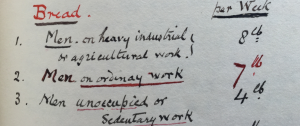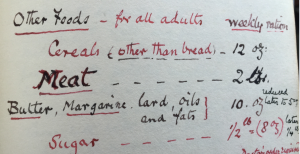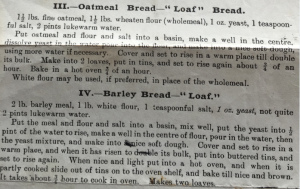REFLECTED IN PARTS OF A RECIPE BOOK CREATED BY NINA BALFOUR AND VICTORIA ALEXANDRINE MONTAGU SCOTT (LATER LADY LOTHIAN)

Recently acquired by Edinburgh University Library is a fine bound manuscript volume of cookery and recipes compiled initially by Lady Nina Balfour of Balbirnie and then continued by Victoria Alexandrine Montagu Scott. The volume was gifted by Balfour to Scott in about 1864-65, presumably in anticipation of her coming marriage, and was added to over some eighty years at Monteviot House (the Borders home of the Marquis of Lothian and the Kerr family).

Noted in the ms volume is the date when rationing started during the Great War
Victoria Alexandrine Montagu Scott was a daughter of the Duke and Duchess of Buccleuch & Queensberry, and she married Schomberg Henry Kerr, 9th Marquess of Lothian on 23 February 1865, becoming Lady Lothian. Lord Lothian was Scottish Secretary, 1887-1892.

Note in the volume of the bread ration for men during the Great War
Spanning the Victorian and Edwardian eras and encompassing two World Wars, the recipes in the ms volume form an interesting chronicle of the Scottish country house diet.The entries for the Great War of 1914 -18 open with notes of rations introduced at different dates, then there are imaginative but parsimonious and largely vegetarian dishes: peelings stock, potato scones, potato bread, vegetable hot pot, savoury parsnips and ‘thrift cake’.

Bread ration for women
Suggesting a role in the local war effort, the volume contains a loosely inserted printed sheet headed Food Controller’s Rations: Some Good Receipts by Lady Lothian. The sheet offered five such ‘Good Receipts’.

Note of rationing of other foods
The post of Food Controller had been appointed in December 1916, and a Ministry of Food Control was also established (the first being the Liberal, Hudson Ewbanke Kearley, Lord Devonport, grocer and politican). The plan was promote economies among the population and to keep moving the supply of food across the country.

‘Some Good Receipts’ from Lady Lothian
However, it was not until 1917, when the Germans began an unrestricted U-boat warfare strategy, that the British government realised how vulnerable the country was to being cut off from imported food supplies. In April 1917 alone, some half a million tons of shipping had been lost in the submarine campaign.

A few of lady Lothian’s recipes, from the printed insert in the volume
The response of the Food Controller was to authorise the organisation of a ‘national kitchen’, where healthy and nourishing food was cooked and served to the population. By then, most men had been called up, and women had taken their places in the workforce. Lady Lothian’s response for the national kitchen was, for example, Barley scones, Oatmeal bread, and Barley bread.

Note in the volume about fresh cream and its use
Rationing was first introduced in the UK in London early in 1918 – though Lady Lothian’s book notes ‘voluntary rations’ in 1917 – and it was extended nationwide by summer 1918 (Rationing Order 1918). Ration cards were issued, and people were required to register with a retailer for meat, butter and sugar, and these would be stamped on purchase of the commodity. Lady Lothian noted in her cookery book that the weekly bread ration for a man depended on his ‘activity’ – whether he was in heavy industrial or agricultural work, in ordinary work, or in sedentary work or unoccupied – and this activity would decide whether he received 8 pounds (3.6 kg), 7 pounds (3.1 kg) or 4 pounds (1.8 kg) of bread per week. For women in heavy industrial or agricultural work, in ordinary work and domestic service, or in sedentary work or unoccupied, the rations were 5 pounds (2.2 kg) , 4 pounds (1.8 kg) and 3.5 pounds (1.5 kg) respectively. For all adults the meat ration was 2 pounds (0.9 kg) per person per week, and sugar 0.5 pounds (0.2 kg) per person per week.

Note of War dates in the ms volume
In addition to the content of the volume (Coll-1741 – MS book of cookery and recipes, begun by Lady Nina Balfour and given to Victoria Alexandrine Montagu Scott, 1864, and continued over 80 years), the websites of the Imperial War Museum, BBC and others were used in compiling this blog post.
Dr. Graeme D. Eddie, Assistant Librarian Archives & Manuscripts, Centre for Research Collections, Edinburgh University Library
![]()







